When I was thinking about choice in my writing workshop, I realized something interesting. At the beginning of the year, writing workshop is the ONLY part of the day where I allow true choice.
For independent reading, I put book bins on tables. I don’t allow students to choose books from the library until we’ve gone over expectations and procedures.
For centers, I tell students what materials to use and what activities to do. Only later do I allow them to choose their materials and activities.
On the other hand, in writing workshop, I have my students choose what they will write (or draw) about from the very first day. They choose what their topics will be – I don’t provide them with any prompts or questions to answer. They also choose what they will say about the topic – I don’t make any requirements about length or anything like that.
Don’t get me wrong – writing workshop certainly isn’t a free-for-all in my classroom. I set high expectations for my students, and sometimes I do limit their topic choices as the year goes on.
But at the beginning of the year, I intentionally put the responsibility on my students for determining what they will write about and what they will say about that topic.
I’ve found that if I start out the year by providing lots of direction, my kids become dependent upon me. They want me to provide them with questions or prompts, and they can’t think of topics on their own.
Providing choice is especially important if I’m teaching students whose previous teacher(s) always gave them direction about what to write. In this case, I need to “re-train” my kids so that they learn to take responsibility for their own topic choices and work.
Choice is an important part of the writing workshop model, and I also think it’s essential in getting kids invested in writing. In today’s post, I’ll describe what writing workshop can look like in the primary grades and suggest practical strategies for providing students with lots of choice during writing time.
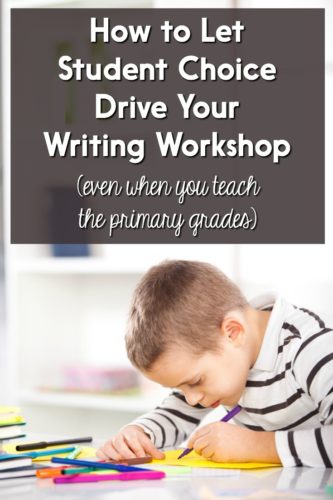
As you’ll read in the sections that follow, I work hard (and sometimes really struggle) to find a balance between letting my kids make choices and helping them become successful writers. So why do I spend so much effort on this when I could just tell them exactly what to write about and how to write about it?
The answer is this: I’ve seen the incredibly powerful impact of choice on my students’ writing.
I’ve worked with struggling writers. I’ve worked with reluctant writers. I’ve worked with Kindergarteners who could not even write or match their name on the first day of school.
And all of these children grew to become more motivated, engaged writers. They came to view writing as a way to tell their stories, teach others, and make real changes in their school and community.
I’m not a miracle worker and I’m not a perfect teacher (sooooo very far from it).
But I’ve given my kids choice in:
- What they write about
- The strategies and techniques they use
- Their writing pace, and
- Their tools and writing spots
And this has made all the difference!
It definitely doesn’t happen overnight, but I’ve seen kids go from needing teacher support to write a single sentence to drafting entire stories independently. And yes, that also takes a lot of intentional teaching, but providing choice has played such a big role in those kids’ successes.
In the following sections, I’ll explain exactly what kind of choices I provide, as well as when I limit or provide more guidance in students’ choices.
Allowing Students to Choose Topics
When I plan my writing units, I decide what genres we will work on and when we will work on them. For example, I may decide that we will be working on nonfiction writing for 6 weeks. I plan mini-lessons on strategies that will help students successfully write informational texts.
Although I choose the genre, students choose the topics for their books. Some kids might be writing books about animals. Other students may write about sports or famous pop singers.
When you first model writing about a topic, students will often copy or imitate your idea by choosing a very similar topic. This is fine, and I absolutely expect this to happen. When I teach my personal narratives unit toward the beginning of the year, I start out by modeling how I write the story of when I fell during a run in the city.
Inevitably, every child in the class decides to write their own personal narrative about a time when they fell and/or got hurt (kiddos tend to have lots of these personal stories to choose from!).
I don’t get upset or frustrated by this – it’s totally normal for our kids to imitate us. But I make a big deal when a student decides to deviate from the topic of my modeled writing. I praise her and tell the class all about how this writer used her own experiences/knowledge to come up with a completely unique topic. And in time, the other kids catch on and begin to do the same.
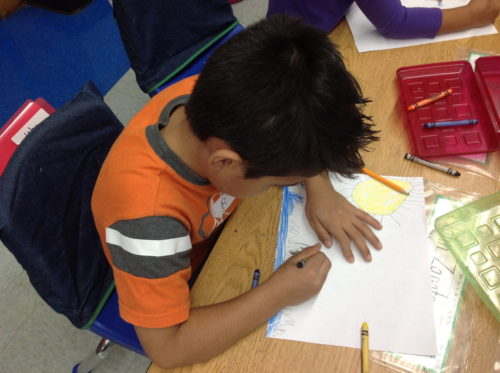
Allowing Students to Choose Writing Strategies
Each day, my writing workshop begins with a brief minilesson. I bring students together on the rug and provide explicit instruction (and often guided practice) on a specific topic. I also usually model writing during the minilesson.
My minilessons usually start with me saying something like, “Writers, today I want to show you how I add details to my story about what characters are thinking” or “Today I want to teach you how I revise my opinion piece by adding in transition words.” I then tell students how to use the strategy, and I model how I use the strategy.
At the end of the minilesson, I invite and encourage students to try out the strategy in their own writing. However, I know that not all students will try out the strategy that same day. They may not understand the skill yet, or it may not be applicable to the stage in the writing process they are in (example: a child who is planning a writing piece will not use the revising strategy I just taught in the minilesson).
It’s not that I don’t care if students listen and use what I teach them. There are certain non-negotiables, which I make clear to students through rubrics and checklists. I also use conferences and small group instruction to provide support to students in trying out the strategies I teach. And sometimes I actually do make students practice the strategy (see the last section of this post for more about that).
But in general, I accept the fact that students may not immediately use the strategies I teach. With time and my support, I strive to help them eventually add it to their repertoires.
Allowing Students to Choose Their Writing Pace
It’s awesome if you can teach drafting strategies when the whole class is drafting. It’s fabulous if you can teach revising when the whole class is revising. And it’s super if you can teach editing skills when the whole class is editing.
But you and I both know that kids work at very different paces.
I mean, if you can get your kids to all finish their work at the same time, then you are amazing and I want to hear your secrets! But I have never been able to pull that off in my own classroom.
So what do I do about that? Well, I just let kids work at their own pace.
This means that, on a given day, some kids may be drafting, others may be brainstorming, and others are revising and editing. They are all usually working within the same genre, but they’re just at different stages in the writing process. I tailor my individual conferences and small group instruction to whatever stage those particular students are in.
When you let kids choose their own pace, that presents some challenges.
I’l have kids who work very slowly, but very productively and precisely. So I check in with them frequently and try to keep track of the number of books they write in a given week. I give them tips for working more quickly and try to motivate them to produce more writing.
Sometimes I have kids who work slowly because they just aren’t staying on task or getting started right away during writing time. I like to begin independent work time by having these kids grab their writing folders and bring them back to the small group table. I help these students get started (it’s not really small group instruction – I just help them get going). When they are ready, I “release” them to go back to their seats and work on their own. Investing some time up front helps me avoid constantly bouncing around between struggling students during independent writing time.
Other kids will work very quickly and not take time to make their work the best that it can be. I work with them on this during individual conferences. I also implement a revising and editing table in my classroom that provides students with opportunities to work together and get help with revising and editing their work from their peers. Kids enjoy working together during writing time, so the revising and editing table is especially important for those “fast finishers” who need to slow down a bit.
And occasionally I do “walk” the entire class through the prewriting, drafting, revising, and editing stages so that we are all on “the same page” at the same time. I often do this when I first introduce a genre of writing, so that they can see me model each stage and then immediately try it on their own. Then, once they’ve completed one piece of writing along with me, I sort of “let them loose” to begin working on additional pieces at their own pace.
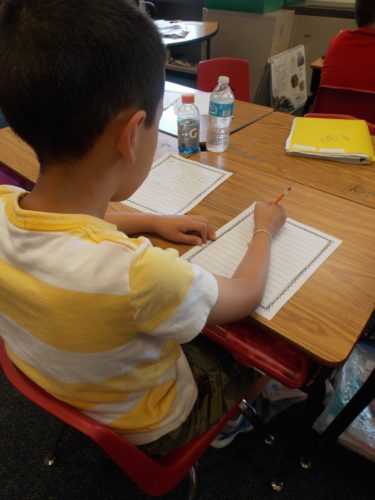
Allowing Students to Choose Tools and Writing Spots
The last (and possibly most fun) way that I incorporate choice is by allowing students to choose their writing tools and writing spots.
I always ask students to use pencils for writing words (although I have heard of teachers having kids use special writing pens, and this sounds awesome, too!). I let kids choose between colored pencils and crayons for illustrating their work (and I always make sure that they have access to these materials, so they’re not interrupting me as I confer with other students).
Sometimes I let students choose the type of booklet in which they are writing. Since I’ve always taught the primary grades, I usually make books for students to write in by stapling together blank and partially lined paper. Depending upon what genre of writing we’re doing, I might let them choose between books with and without a table of contents, books with differently-styled cover templates, or books with different numbers of pages. It’s a relatively simple way to let kids decide how they want their books to look.
When I had 1:1 iPads in my classroom, I sometimes let my Kindergarteners choose to write on the iPad. This wasn’t always a choice, because I think our little ones need to practice writing (with writing utensils and paper) to develop those important fine motor skills. But if my kids needed a little extra motivation to stay on task or get work done, I sometimes let them choose between writing on the iPad and writing on paper.
Letting kids choose writing spots is another fun way to provide choice. Much of the time, my kids wrote at their seats. But when I had clipboards available, I sometimes let them choose a spot in the classroom to sit and write. I have my own favorite cozy spots for writing (like out on my deck – where I am right now!), and kids really appreciate the chance to find their own special spots, too.
When To Limit Student Choice
All of that said…not everything is always a choice.
Sometimes I will give students specific topics to write about. I may ask them to respond to a story, answer a question, or choose a topic from several choices.
From time to time, I will require that students try out a strategy on the very same day that I teach it. I might say, “Okay, now that I showed you how I add headings to my nonfiction piece, I want you to take out one of your finished nonfiction books. You’re going to reread it and add a heading to each page before you get started on your other work.”
As I mentioned previously, I also sometimes set the pace for students. We may go through an entire piece of writing together, and I make sure that every child is drafting at the same time, revising at the same time, etc. This is especially important when I’m introducing a new genre.
Too many choices can be frustrating and overwhelming for students who have special needs. To meet these students’ needs, I don’t take away choices from the entire class – I just modify the individual student’s task and provide him with fewer (or no) choices.
Writing Units
If you can’t tell by now, I love teaching writing. 🙂 I’ve created writing lessons for Kindergarten, first, and second grade to help other teachers love teaching writing, too! Watch the video below to learn more about the units and the story behind how I developed them:
To read more about the units, please click on any of the images below. And feel free to contact me if you have any questions!
Do you have any other suggestions for allowing choice during writing time? Please comment below – I’d love to hear from you!

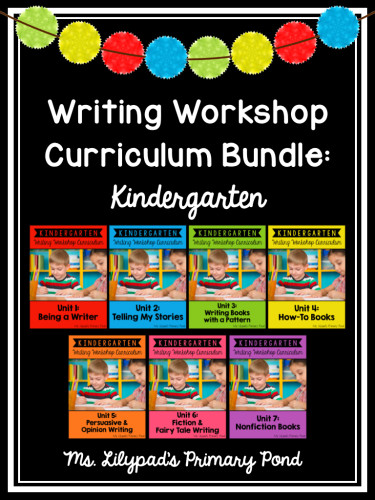
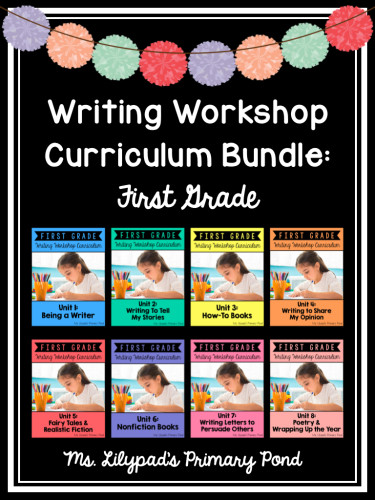


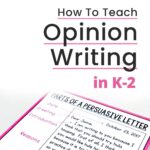
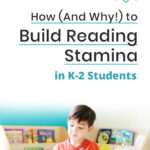

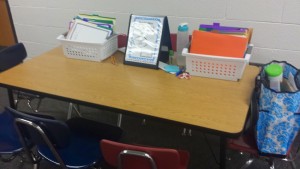
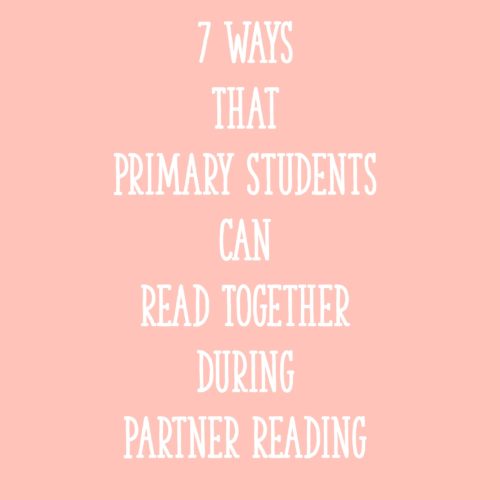






I think this is amazing. I teach 2nd grade and writing is very challenging for me to travh as s student I was a struggling writer. I can’t wait to order this and try it this year! Thank you so much for writing this.
Thank you so much, Charlotte! I hope the materials are helpful to you this year! 🙂
Alison
I bought the first grade bundle at the beginning of the summer and have all of the units printed out and in a binder. I love that the plans are so detailed and can’t wait to try them out with my kiddos. I’m looking forward to the workshop tomorrow! Thank you for all of your hard work!!
So glad you can join us, Susan!! 🙂
Alison
Hi, anyway you could create this for 5th grade?
I love your writing units. I’ve purchased your 2nd grade and this year I’m looking into 1st grade and would also like something for 3rd. Any suggestions for 3rd?
Thank you so much!
Hi Kim! So glad to hear you like them!! I have not used her units personally, but I follow Jen Bengel on Facebook and she has some really good ideas. You can check out her units here: https://www.teacherspayteachers.com/Store/Jen-Bengel/Category/Grade-3-Units-of-Study-256865
I hope this helps!
Alison
Thank you! This is very helpful